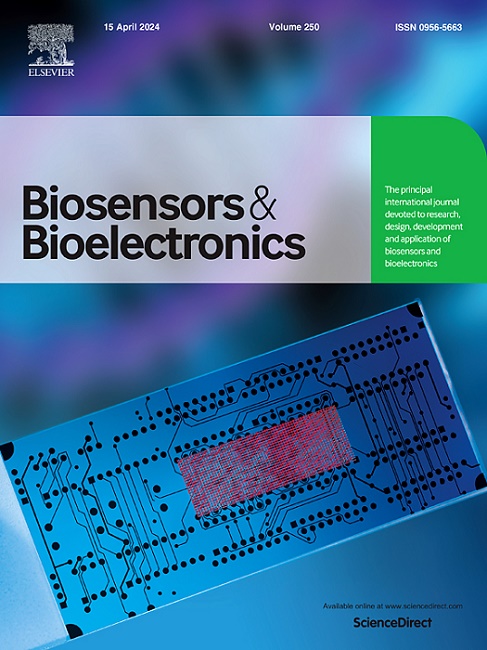Dual action electrochemical bandage operated by a programmable multimodal wearable potentiostat
IF 10.7
1区 生物学
Q1 BIOPHYSICS
引用次数: 0
Abstract
We have developed electrochemical bandage (e-bandage) prototypes that generate the reactive oxygen species hypochlorous acid (HOCl) or hydrogen peroxide (H2O2) for potential use to treat biofilm-infected wounds in humans. We have shown that both e-bandage-generated HOCl and H2O2 kill biofilms in vitro and in infected wounds on mice, with the former being more active in vitro. The H2O2-generating e-bandage, more so than the HOCl-generating e-bandage, was associated with improved healing of infected wounds. Here, a strategy in which H2O2 and HOCl are alternately generated—for dual action—was explored. The goal was to develop a programmable multimodal wearable potentiostat [PMWP] that can generate HOCl or H2O2, as needed. An ultralow-power microcontroller unit was developed to manage operation of the PMWP. The system was operated with a 260-mAh capacity coin battery and weighed 4.6 g, making it suitable for future small animal experiments (and ultimately, potential evaluation in humans). As assessed using electrochemical parameters, the device functioned comparably to a commercial benchtop potentiostat. To confirm antimicrobial activity, PMWP-controlled e-bandages were tested in vitro against clinical isolates of methicillin-resistant Staphylococcus aureus, Pseudomonas aeruginosa, Acinetobacter baumannii, Enterococcus faecium, and Candida auris. When programmed to deliver HOCl followed by H2O2, PMWP-controlled e-bandages exhibited activity against biofilms of all study isolates tested. Finally, we demonstrated the PMWP's usability in a murine wound infection model.
由可编程多模式可穿戴恒电位仪操作的双作用电化学绷带。
我们已开发出可产生活性氧物种次氯酸(HOCl)或过氧化氢(H2O2)的电化学绷带(e-bandage)原型,有望用于治疗人类受生物膜感染的伤口。我们的研究表明,电子绷带产生的 HOCl 和 H2O2 都能在体外和小鼠受感染的伤口中杀死生物膜,其中前者在体外的活性更高。产生 H2O2 的电子绷带比产生 HOCl 的电子绷带更能改善受感染伤口的愈合。在这里,我们探索了一种交替产生 H2O2 和 HOCl 以实现双重作用的策略。我们的目标是开发一种可编程的多模式可穿戴恒电位仪 [PMWP],它可以根据需要产生 HOCl 或 H2O2。我们开发了一个超低功耗微控制器单元来管理 PMWP 的运行。该系统使用 260 毫安时容量的纽扣电池运行,重量仅为 4.6 克,适合未来的小动物实验(最终可能用于人体评估)。根据电化学参数评估,该装置的功能与商用台式恒电位仪相当。为确认抗菌活性,对 PMWP 控制的电子绷带进行了体外测试,以检测耐甲氧西林金黄色葡萄球菌、铜绿假单胞菌、鲍曼不动杆菌、粪肠球菌和白色念珠菌的临床分离物。当编程以输送 HOCl 后再输送 H2O2 时,由 PMWP 控制的电子绷带对所测试的所有研究分离物的生物膜都具有活性。最后,我们证明了 PMWP 在小鼠伤口感染模型中的可用性。
本文章由计算机程序翻译,如有差异,请以英文原文为准。
求助全文
约1分钟内获得全文
求助全文
来源期刊

Biosensors and Bioelectronics
工程技术-电化学
CiteScore
20.80
自引率
7.10%
发文量
1006
审稿时长
29 days
期刊介绍:
Biosensors & Bioelectronics, along with its open access companion journal Biosensors & Bioelectronics: X, is the leading international publication in the field of biosensors and bioelectronics. It covers research, design, development, and application of biosensors, which are analytical devices incorporating biological materials with physicochemical transducers. These devices, including sensors, DNA chips, electronic noses, and lab-on-a-chip, produce digital signals proportional to specific analytes. Examples include immunosensors and enzyme-based biosensors, applied in various fields such as medicine, environmental monitoring, and food industry. The journal also focuses on molecular and supramolecular structures for enhancing device performance.
 求助内容:
求助内容: 应助结果提醒方式:
应助结果提醒方式:


